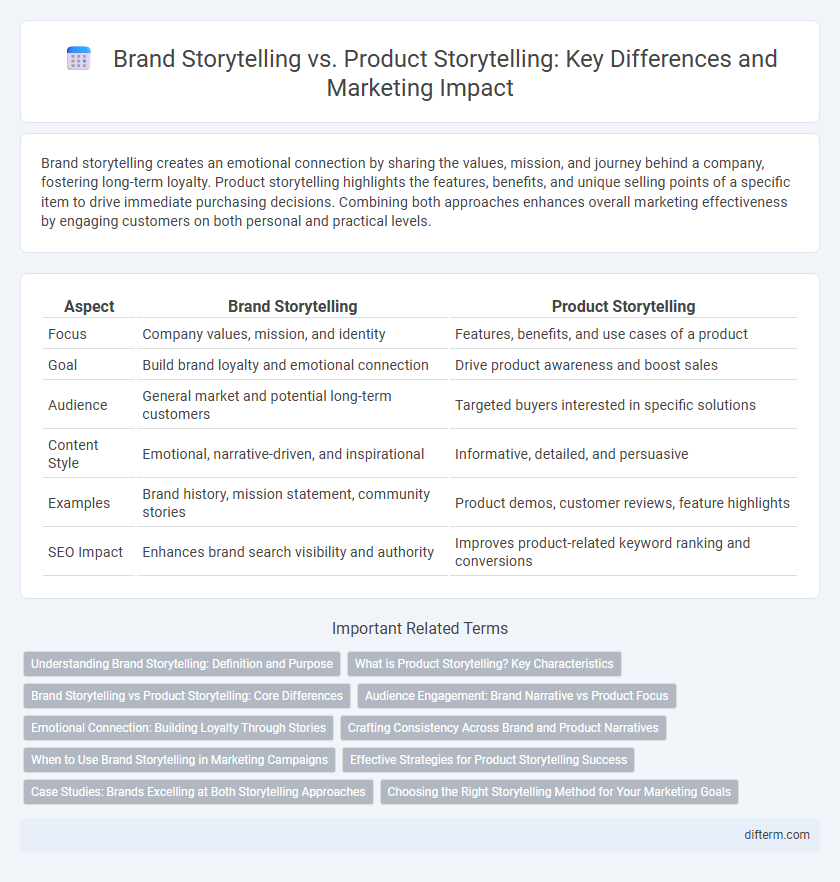Brand storytelling creates an emotional connection by sharing the values, mission, and journey behind a company, fostering long-term loyalty. Product storytelling highlights the features, benefits, and unique selling points of a specific item to drive immediate purchasing decisions. Combining both approaches enhances overall marketing effectiveness by engaging customers on both personal and practical levels.
Table of Comparison
| Aspect | Brand Storytelling | Product Storytelling |
|---|---|---|
| Focus | Company values, mission, and identity | Features, benefits, and use cases of a product |
| Goal | Build brand loyalty and emotional connection | Drive product awareness and boost sales |
| Audience | General market and potential long-term customers | Targeted buyers interested in specific solutions |
| Content Style | Emotional, narrative-driven, and inspirational | Informative, detailed, and persuasive |
| Examples | Brand history, mission statement, community stories | Product demos, customer reviews, feature highlights |
| SEO Impact | Enhances brand search visibility and authority | Improves product-related keyword ranking and conversions |
Understanding Brand Storytelling: Definition and Purpose
Brand storytelling involves crafting a compelling narrative that communicates a brand's values, mission, and identity to create an emotional connection with the audience. Its purpose is to build long-term brand loyalty by emphasizing the brand's personality and vision rather than focusing solely on individual products. This approach helps differentiate the brand in a competitive market by fostering trust and recognition through consistent, meaningful stories.
What is Product Storytelling? Key Characteristics
Product storytelling centers on conveying the unique features, benefits, and functionalities of a specific product to engage customers and drive purchase decisions. Key characteristics include a clear focus on the product's value proposition, real-life applications, and emotional appeal that connects user needs with product solutions. Effective product storytelling employs visuals, customer testimonials, and narratives that highlight problem-solving capabilities to differentiate the product in a crowded marketplace.
Brand Storytelling vs Product Storytelling: Core Differences
Brand storytelling centers on communicating the company's mission, values, and identity to create emotional connections and long-term loyalty, while product storytelling focuses on highlighting specific features, benefits, and use cases to drive immediate sales. Brand storytelling uses narrative elements that build trust and brand equity over time, whereas product storytelling emphasizes clear, detailed information aimed at conversion. Understanding these core differences helps marketers craft strategies that balance emotional engagement with practical product appeal.
Audience Engagement: Brand Narrative vs Product Focus
Brand storytelling fosters deep audience engagement by creating an emotional connection through a compelling brand narrative that reflects core values and mission. Product storytelling, on the other hand, centers on specific features and benefits, appealing to customers through practical solutions and detailed information. Brands leveraging narrative-driven content often see increased loyalty and long-term engagement compared to purely product-focused messaging.
Emotional Connection: Building Loyalty Through Stories
Brand storytelling creates a deep emotional connection by sharing a company's values and mission, fostering authentic loyalty among consumers. Product storytelling highlights specific features and benefits, appealing directly to customer needs but often lacks the broader emotional impact of brand narratives. Emotional engagement in brand storytelling leads to stronger customer retention and long-term loyalty by making the brand relatable and memorable.
Crafting Consistency Across Brand and Product Narratives
Crafting consistency across brand and product narratives ensures a unified customer experience that strengthens brand identity and trust. Integrating key brand values into product storytelling creates emotional resonance, making each product a reflection of the overall brand promise. Aligning tone, messaging, and visual elements across all storytelling channels solidifies recognition and drives engagement in competitive markets.
When to Use Brand Storytelling in Marketing Campaigns
Brand storytelling should be used in marketing campaigns when the goal is to build long-term emotional connections and establish a strong brand identity that resonates with the target audience. It works best for creating brand loyalty and differentiating from competitors by communicating core values, mission, and vision. Campaigns aimed at increasing brand awareness or repositioning the brand in a competitive market benefit significantly from strategic brand storytelling.
Effective Strategies for Product Storytelling Success
Effective product storytelling hinges on highlighting unique features, benefits, and real-life applications to create emotional connections with the audience. Leveraging customer testimonials, vivid visuals, and clear narratives that demonstrate problem-solving capabilities enhances engagement and trust. Integrating data-driven insights to tailor stories for target demographics maximizes relevance and conversion rates in product marketing campaigns.
Case Studies: Brands Excelling at Both Storytelling Approaches
Nike and Apple master brand storytelling by creating emotionally resonant narratives that emphasize their core values and cultural impact, fostering strong consumer loyalty. Tesla excels in product storytelling by showcasing innovation and performance through detailed, compelling demonstrations of its electric vehicles' capabilities and sustainability features. Both approaches drive consumer engagement effectively when integrated strategically, as evidenced by these brands' market dominance and high customer retention rates.
Choosing the Right Storytelling Method for Your Marketing Goals
Brand storytelling emphasizes the company's values, mission, and emotional connection with the audience, fostering brand loyalty and long-term engagement. Product storytelling centers on highlighting specific features, benefits, and use cases to drive immediate sales and showcase product value. Selecting the right method depends on marketing goals: brand storytelling suits awareness and loyalty campaigns, while product storytelling is effective for conversions and product launches.
Brand Storytelling vs Product Storytelling Infographic

 difterm.com
difterm.com